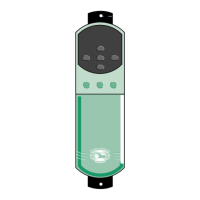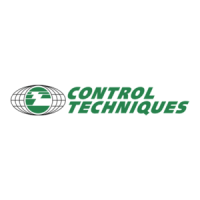Unidrive
LV
model sizes 1 to 3 Installation Guide
Issue code: uliu1
2-14 Installing the Drive
2.4 Calculating the
enclosure size
STEP 1 Add the dissipation figures from step 4 of
Planning the installation for each Drive that is to
be installed in the enclosure. Make a note of
this step number and the total value.
S
TEP 2 If an RFI filter is to be used with each
Drive, add the dissipation figures from step 5 of
Planning the installation for each RFI filter that is
to be installed in the enclosure. Make a note of
this step number and the total value.
S
TEP 3 If the braking resistor is to be mounted
inside the enclosure, add the average power
figures from step 8 of Planning the installation for
each braking resistor that is to be installed in
the enclosure. Make a note of this step number
and the total value.
S
TEP 4 Make a note of this step number and the
total heat dissipation (in Watts) of any other
equipment to be installed in the enclosure.
S
TEP 5 Add the heat dissipation figures obtained
(as appropriate) from steps 1, 2, 3 and 4 above.
This gives a figure in Watts for the total heat
that will be dissipated inside the enclosure.
Make a note of this figure and the step number.
Calculating the size of a
sealed enclosure
The enclosure transfers internally generated heat
into the surrounding air by natural convection (or
external forced air flow); the greater the surface
area of the enclosure walls, the better is the
dissipation capability. Only the surfaces of the
enclosure that are unobstructed (not in contact
with a wall or floor) can dissipate heat.
Calculate the minimum required unobstructed
surface area A
e
for the enclosure from:
A=
P
k(T - T )
e
int ext
Where:
A
e
Unobstructed surface area in m
2
(1m
2
= 10.8 ft
2
)
T
ext
Maximum expected ambient
temperature in °C outside the enclosure
T
int
Maximum permissible ambient
temperature in °C inside the enclosure
P Power in Watts dissipated by all heat
sources in the enclosure
k Heat transmission coefficient of the
enclosure material in W/m
2
/°C
Example
To calculate the size of an enclosure for the
following:
• Two UNI 1205 models
• Each Drive to operate at 4.5kHz
PWM
switching frequency
• RFI filter for each Drive
• Braking resistors are to be mounted outside
the enclosure
• Maximum ambient temperature inside the
enclosure: 40°C
• Maximum ambient temperature outside the
enclosure: 30°C
Dissipation of each Drive: 190W (from step 4 in
Planning the installation)
Dissipation of each RFI filter: 25W (max) (from
step 5 in Planning the installation)
Total dissipation: 2 x (190 + 25) = 430W
The enclosure is to be made from painted 2mm
(
3
/
32
in) sheet steel having a heat transmission
coefficient of 5.5W/m
2
/°C. Only the top, front, and
two sides of the enclosure are to be free to
dissipate heat.
Figure 2–6 Enclosure having front, sides and
top panels free to dissipate heat
